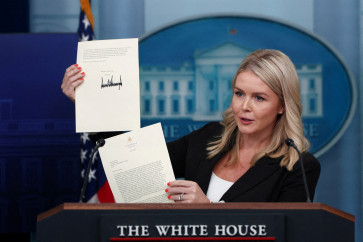Popular Reads
Top Results
Can't find what you're looking for?
View all search resultsPopular Reads
Top Results
Can't find what you're looking for?
View all search resultsIn memoriam: Keith Emerson as we (didn't) know him
When we learned of the death of Keith Emerson, keyboardist and composer of the English progressive rock group Emerson, Lake and Palmer (ELP) on March 10, we did not lose just another rich and famous musician
Change text size
Gift Premium Articles
to Anyone
W
hen we learned of the death of Keith Emerson, keyboardist and composer of the English progressive rock group Emerson, Lake and Palmer (ELP) on March 10, we did not lose just another rich and famous musician.
We lost a pioneer in bridging genres in music and someone who shaped the love of classical music for those who hated classical music before.
Born on Nov. 2, 1944 in Todmorden, Yorkshire, Emerson studied classical and jazz music before blending them with rock into a style that eventually brought him critical and commercial success.
As stated in his biography, Emerson described himself: 'I was a very serious child. I used to walk around with Beethoven sonatas under my arm. However, I was very good at avoiding being beaten up by the bullies. That was because I could also play Jerry Lee Lewis and Little Richard songs. So, they thought I was kind of cool and left me alone.'
He started the 'classical' side of his career ' just as we all do ' by imitating, but this imitation didn't stop there. It became transformation and transformation became a search for an identity.
Still, until the end of his life he was stereotyped as a progressive rocker ' because that's what he was and he was more focused on that aspect. Thanks to his 'transformation' period, thousands or perhaps millions, which includes me (who admitted it in some interviews since I was in my 20s), were introduced to the classical world 'from another door'.
The first piece that bridged his 'imitation' to 'transformation' period was based on Modest Mussorgsky's Pictures at an Exhibition and he also tinkered with other classical works such as Johann Sebastian Bach's Italian Concerto, thus established the new genre 'symphonic rock' or 'classical rock'.
In his rendition of Aaron Copland's Fanfare for the Common Man he still needed Copland's original music not only to frame his own music (which is clearly in rock style) but also to extract the material from the great American composer's music.
Emerson's 20-minute 'Piano Concerto No. 1' (which appeared on the vinyl ELP Works in 1977 as the only work on side one ' curiously enough he never omitted the number 1, even though he never wrote a 'No. 2') could be compared to George Gershwin's 'Piano Concerto in F': an original work that established the musical identity of the composer.
A pity is that this piece wasn't particularly well received by classical music fans and performers or by ELP fans, although I consider it the pinnacle of Emerson's classical concept.
I am not sure if it was prejudice over the fact that it was composed by a rock guy, or an uncomfortable feeling from rock fans about something that was entirely not rock. It is, in artistic terms, a really solid piece of music with elaborate developments and not one note too many.
It was written in three different movements although there doesn't seem to be much cohesion between them. It is as if he opened a door and found a fascinating world but he hesitated to enter. It certainly is not the kind of 'beginner's guide to classical music' or 'classical music for classical haters' since it is not 'light' at all; on the contrary, it is quite sophisticated in exploiting its motifs and is not just a series of spontaneous improvisations. Therefore, one's ear should already be used to classical music in order to grab the whole musical concept and beauty of this work.
Emerson won't be remembered as a prominent composer in classical music, since one couldn't say it based on his very few original musical works, but he is important in musical history in the sense of being one of the first composers, after George Gershwin or Kurt Weill, who has his feet in two musical worlds after coming from rock.
In fact, his feet are more firmly planted in progressive rock rather than in classical music, which appeared to be just a kind of phase in his life. But still, it was inspiring to many classical musicians as an example of not staying in one's comfort zone for the enrichment of the musical language.
In Indonesia we have the example of Addie MS who came from a pop music background and then crossed the bridge to classical music land and became its primary exponent.
In the younger generations we have some accomplished musicians who have done the contrary journey: going from classical to other genres. The most famous example nowadays is Isyana Sarasvati, who studied classical piano and vocals, to the level of graduating from the National University of Singapore as a classical vocalist and won our country's National (classical) Vocal Competition, but is now firmly established as a pop singer and songwriter.
The same could be mentioned about the more senior Artidewi, who among others wrote ' and performed ' the jazz song 'Hush' for the film The Raid 2 and at the moment is preparing to take part in a classical opera in May.
The young rising star Mariska Setiawan, who as an acclaimed classical soprano is specializing in music based on mostly Indonesian poems and other literary works (which is still a new concept in Indonesia) can also be found in her occasional gigs and recordings in her own pop songs, either original ones or covering the songs of her idol David Bowie.
In purely singing terms, Julius Firdaus has used his weird, intriguing countertenor voice (another quite new thing for Indonesia!) for different genres with extraordinary control. In fact, it was this prowess that made the trap he himself fell into during the semifinals of the highly popular TV show, Australia's Got Talent: He wanted to turn this rare skill into a wizardry of technical possibilities of just about three minutes.
The judges did not fail him for his brilliant capabilities; they did it for not being able to focus on one genre, or even failing to define the name of that genre. And promoters need a name for genres, in order to have a clear brand to sell.
Julius has not established his position in a specific genre and maybe he doesn't need to, but his talent is inspiring and perhaps a composer who would like to exploit his abilities should establish a new genre ' and musical concept ' too, just like what Keith Emerson did.
It is nevertheless still unclear who coined the term 'symphonic (or classical) rock'. Certainly it wasn't him. However, let's remember that Ludwig van Beethoven did not invent the term 'romantic music', nor did Igor Stravinsky establish the term 'neo-classical', although both were pioneers of those styles (in fact Stravinsky hated that term). They just imitated, transformed and found a new 'sound'.
As his colleague from ELP Carl Palmer remembered Emerson on his Facebook page: 'He was a pioneer and an innovator whose musical genius touched all of us in the worlds of rock, classical and jazz.' Perhaps when John Lennon wished there were no countries nor religions, he could have wished there were no genres in music either.
' The writer is a composer and pianist










